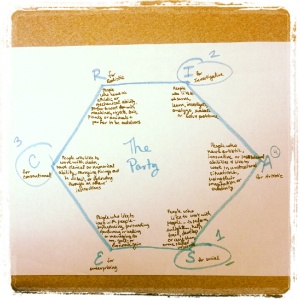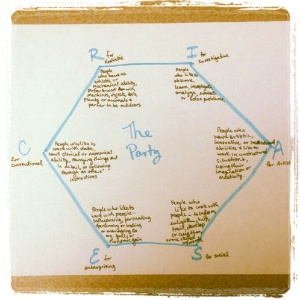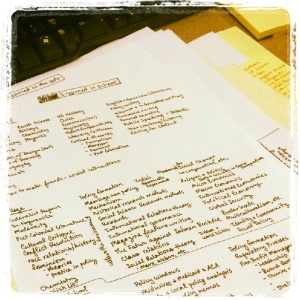Step 2 for creating That One Piece of Paper is called “What are your preferred People-Environments that you are most like to work with, or serve and help?” The basic idea is to figure out what kind of people you want to be surrounded by.
What Color is Your Parachute? suggests a scientific categorization and quiz developed by Dr. John L. Holland to describe six different people-environments. These environments are:
Realistic: People who have an athletic or mechanical ability, prefer to work with machines, objects, tools, plants or animals and prefer to be outdoors.
Investigative: People who like to observe, learn, investigate, analyze, evaluate, or solve problems.
Artistic: People who have artistic, innovative, or intuitional abilities and like to work in unstructured settings, using their imagination and creativity.
Social: People who like to work with people — to inform, enlighten, help, train, develop or cure them, or are skilled with words.
Enterprising: People who like to work with people — influencing, persuading, or performing or leading or managing for organizational goals or economic gain.
Conventional: People who like to work with data, have clerical or numerical ability, carrying things out in detail, or following through on others’ instructions.
The author of What Color is Your Parachute put together an exercise that helps people decide what group of people they would like to be with. The book reads:
Below is an aerial view of a room in which a party is taking place. At this party, people with the same or similar interest have (for some reason) all gathered in the same corner of the room.
1) Which corner of the room would you instinctively be drawn to, as the group of people you would most enjoy being with for the longest time? (Leave aside any question of shyness, or whether you would have to talk to them.) Write down the letter for that corner.
2) After fifteen minutes, everyone in the corner you have chosen leaves for another party crosstown, except you. Of the groups that still remain now, which corner or group would you be drawn to the most, as the people you would most enjoy being with for the longest time? Write down the letter for that corner.
3) After fifteen minutes, this group too leaves for another party, except you. Of the corners and groups which remain now, which one would you most enjoy being with for the longest time? Write down the letter for that corner.
The three letters you just chose, in the three steps, are called your “Holland Code.”
I have a tendency to cheat on activities like these, and put how I would LIKE to be instead of how I actually am. So, I skipped to using what the internet has to offer based on the suggestions in the book. I took two tests. One was at http://www.self-directed-search.com/, which cost $4.95 and one was at http://careerkey.org/asp/your_personality/take_test.asp, which cost $9.95.
My results for Self-Directed Search looked like this:
R = 10, I = 25, A = 21, S = 37, E = 26, C = 26
My results for the Career Key test looked like this:
Artistic = 9
Conventional = 6
Enterprising = 3
Investigative = 5
Realistic = 5
Social = 16
It was clear, by far and away, that my first letter is “S” for social. But after that, all the scores bunch up. In fact, one of the explanation of scores for SDS said that a difference of less than 8 was negligible. (An aside: Barbara Sher says that her Scanners tend to have high scores in most categories on most aptitude tests. Confirmation bias?)
So I thought about it. And I ended up deciding that at the party, I would definitely like to hang out with the Social crowd. I like helping people. And then, I decided that I would probably like to hang out with the Investigative crowd. I like learning new things and solving problems. And finally, to be honest, I probably would like to hang out with the conventional crowd. I like things that are clear cut and having specific instructions. I put that Artistic is probably a close fourth, considering that one was one I WANTED to put in, perhaps as the second one, and that I do think of myself as a creative.
Now my party looked like this:

Which resulted in writing the following “temporary statement” on my flower: I would like a job or career best if I were surrounded by people who like to work with people and help them (S), like to investigate and analyze things (I), and who work with data and details and instructions (C). (And sometimes people who use imagination and creativity (A).)
Now my flower, my “One Piece of Paper” looks like this:

(I haven’t picked out my reward yet. But I will soon! I’m thinking a shirt for more casual wear.)


 So, you might be aware that I am about half way through my Masters in Public Policy. At the end of these two years of school, I’d like to get a job. To get a job, I will have to prepare. I know from finding my internship this past winter that it will take work to know myself well enough to sell myself well enough to land a job that will fit with me, and allow me to do the work that I want to do in the world.
So, you might be aware that I am about half way through my Masters in Public Policy. At the end of these two years of school, I’d like to get a job. To get a job, I will have to prepare. I know from finding my internship this past winter that it will take work to know myself well enough to sell myself well enough to land a job that will fit with me, and allow me to do the work that I want to do in the world.